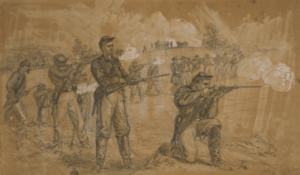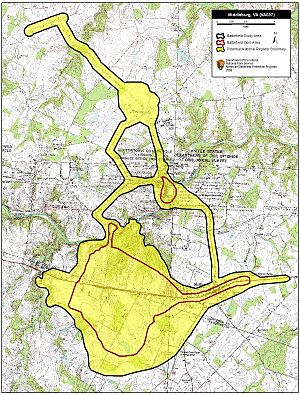Battle of Middleburg facts for kids
Quick facts for kids Battle of Middleburg |
|||||||
|---|---|---|---|---|---|---|---|
| Part of the American Civil War | |||||||
 1st Maine Cavalry Skirmishing by Alfred R. Waud. |
|||||||
|
|||||||
| Belligerents | |||||||
| Commanders and leaders | |||||||
| David McM. Gregg | J.E.B. Stuart | ||||||
| Strength | |||||||
| Divisions | Divisions | ||||||
| Casualties and losses | |||||||
| 97 | 40 | ||||||
The Battle of Middleburg happened from June 17 to June 19, 1863. It took place in Loudoun County, Virginia. This battle was part of the larger Gettysburg Campaign during the American Civil War.
During this time, Confederate Maj. Gen. J.E.B. Stuart was trying to protect Robert E. Lee's army as it moved. He faced off against Maj. Gen. Alfred Pleasonton's Union cavalry. On June 17, a small Union group, the 1st Rhode Island Cavalry Regiment, was attacked. They suffered heavy losses. Two days later, on June 19, Union forces pushed Stuart's cavalry back. Both sides received more troops, and fighting continued. Stuart's forces slowly had to retreat, but they still guarded the important mountain passes.
Contents
What Happened on June 17?
General Stuart set up his main camp in Middleburg. He spread out his cavalry groups across the Loudoun Valley. This was to watch for any enemy movements.
A Bold Union Ride
Early on June 17, Colonel Alfred N. Duffié led about 280 men from the 1st Rhode Island Cavalry. They rode west from the main Union camp. Their orders were to reach Middleburg that evening. They were then to continue further west the next day.
Duffié's group crossed the Bull Run Mountains easily. They pushed past a few Confederate guards. Confederate leaders found it hard to believe such a small Union group would ride so deep into their territory. They thought it might be the start of a much larger attack. So, they did not attack Duffié's group right away.
Surprise in Middleburg
Around 4:00 p.m., Duffié's cavalry reached Middleburg. They quickly drove away the few Confederate guards there. This surprise attack interrupted General Stuart's evening plans. Stuart and his officers quickly left town. He ordered his closest cavalry group to move to Middleburg right away. Their mission was to defeat the Union cavalry.
Colonel Duffié prepared for a fight. He blocked the streets of Middleburg. He also had half of his men get off their horses and hide behind stone walls. He sent a message asking for help from another Union group nearby.
The Rhode Islanders Are Overwhelmed
At 7:00 p.m., Stuart's forces attacked. The Union cavalry was greatly outnumbered. The Rhode Islanders were quickly defeated. Many of Duffié's men were captured the next morning. Colonel Duffié himself returned to his camp with only a few officers and men. The Union lost about 250 soldiers on June 17.
The Fight on June 19
After another battle nearby, Stuart stayed on defense. He wanted to stop any Union attempts to cross the Blue Ridge Mountains. Union General Pleasonton sent small groups to test the Confederate defenses.
Confederate Retreat and Union Advance
On June 18, Union forces met Confederate guards near Middleburg. Stuart's men quickly moved back to a strong position west of town. Pleasonton was careful. He ordered his men to pull back to avoid a trap.
The next day, June 19, Union forces moved towards Middleburg again. Colonel John Irvin Gregg led his cavalry group against the Confederates. Another Union group moved north to attack from a different direction. This group pushed back some Confederate soldiers in a small fight.
A Hard-Fought Battle
Colonel Gregg's men had a tough fight to clear the Confederate guards from Middleburg. The Confederate position on the high ground beyond the town was very strong. Gregg asked for more support before attacking. Other Union groups sent soldiers to help. Gregg's forces slowly moved forward.
The weather was very hot, around 98°F (37°C). This made both soldiers and horses tired. After several Union attacks, Stuart's horse artillery (cannons pulled by horses) had to retreat. Then his cavalry also pulled back. Several Confederate counterattacks failed to win back the high ground.
Nightfall and Retreat
Later that day, more Union soldiers arrived. They captured a fiercely fought-over hill south of a small village. As darkness fell, Stuart was forced to leave his position. He retreated along the main road to some stone walls behind a stream. General Pleasonton was still cautious. He ordered his men to rest and set up guards instead of chasing the Confederates.
The Union army lost 16 killed, 46 wounded, and 37 missing on June 19. Stuart's forces lost about 40 men. This included his chief of staff, Heros von Borcke. He was badly wounded in the neck. He survived but the injury affected his health for the rest of his life.
Battlefield Preservation
Today, groups like the American Battlefield Trust work to protect these historic places. They have saved about 5 acres (20,000 square meters) of the Middleburg battlefield. Middleburg is a very old and beautiful town in Virginia. Many buildings from the Civil War era are still there. Some were even used as hospitals. The town is also part of the John Singleton Mosby Heritage Area. A special center nearby tells the story of Mosby's Rangers, a famous Confederate cavalry group.


